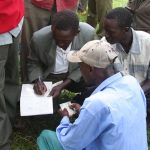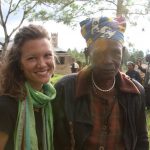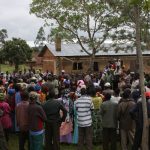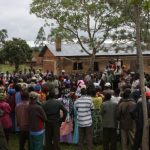22 October 2008 
So we had a big victory today that I would like to share with all of you to give you a little “pick me up” after all the gloom and doom of lightning strikes and malaria cases. I need to give you a little backstory, though, first.
One of the hardest things to do in our work here is something called community mobilization. “Community mobilization” – now that sounds like a horrible dry and lifeless “NGO word.” In all actuality, though, it is central to anything we do in the Nuru model. Community mobilization simply means getting the word out to the community you are working with about the program or project you want to start, getting them to buy into that program, and then getting them to come and begin participating in the project. Sounds simple enough…right? Wrong. Unfortunately, this critical element in our strategy is one of the most difficult to do here in the Kuria District. Community mobilization has been and always will be a challenge for those attempting to truly partner with communities to fight poverty.
What does community mobilization look like for Nuru? Let me explain a bit. We work with groups of individuals from the community. Why groups? The individuals that struggle daily here to provide a life for their families are strong. They are survivors. But the challenges of everyday life are extraordinarily difficult and far too much for any one single individual to handle alone. When they unite together in groups, though, incredible things can happen. They begin to trust and depend on one another in a compassionate, caring way. When one member suffers, all the others come together to help meet that individual’s need. Many of the people in impoverished communities already know and embrace this model. They form women’s groups, youth groups, self-help groups – all with the aim of improving the lives of its members together as a unit. We have seen that strength, and we are tapping into that wisdom in our model. We mobilize the community through groups.
So back to the challenge of community mobilization…why is it so hard? Why is it so hard to get the word out about what Nuru wants to do in the community, get people behind it, and then get them to come and participate? Can’t we just post up a bunch of signs, call all the leaders, have a big meeting a few times, even film the meetings where we talk about the program and show it to others that couldn’t make it? No, I’m afraid it’s a bit more challenging than that. Imagine for a second the situation this community faces.
Why is it so hard to get the word out? No one has cell phones. If they do, they don’t have enough money to buy airtime (minutes) to be able to actually talk with one another to communicate. You can’t just put up posters – few of them can read or write. You can’t just go tell everyone – many of them live deep in the interior, and it would take weeks to visit every home. Then of course, you have the language barrier. Our team speaks decent Swahili, but unfortunately, many of the people in the deep interior (those who are poorest and the ones we wish to reach the most) only speak decent Swahili as well – their first language being their native tongue, Kikuria.
Why is it so hard to get people behind the program? The people of Kuria are a proud, hard-working good people, and unfortunately, they, like many other impoverished communities around the world, have been taken advantage of by both well-meaning and corrupt NGOs. You wouldn’t believe some of the ways you can destroy a person’s faith and trust in outsiders. Groups have come and gone – all making empty promises and then raping the community of its last shilling. Many of the people are fed up…it takes time to build trust and a sense of mutual respect.

Why is it so hard to just get them to come and participate? I think the best way to illustrate this challenge is through a story. During one of our initial meetings, we were explaining Nuru’s program to several leaders in the community. At the end, we asked for questions from the crowd. An elderly woman (in her early 70s) raised her hand. “Yes, mama – you have a question?” Philip asked. “Yes,” she said. “I was just wondering if you could be kind enough to hold your meetings in more than one location so that we don’t have to travel so far.” I paused – thinking what a logistical nightmare that would be. Surely she hadn’t traveled farther than 10 or 15 minutes to get to the community health center where the meeting was being held. As I began to think through all the various inconveniences we would have to go through to hold separate meetings, I was silenced as she continued. “You see,” she said. “I had to walk over two hours to get here.” These guys have no cars (only one man in the 5,000 in the community owns a car). Very few own bikes. Since she asked that question, I have begun to learn the challenges of getting around here in Kuria. It now takes me an hour and a half just to walk to work every day – over terrible, muddy roads (or goat trails) and extraordinarily rough terrain. Every time we held a meeting, this old lady would have to get up at the crack of dawn to finish a day’s work on her farm, draw water for her family for the day, fix a meal of enough food to feed her family, and then walk over two long hours up and down the hills here to a meeting to listen to some white guy talk about groups. Then afterwards, she had to walk over two hours back and hope that she could make it back by nightfall so that she doesn’t get jumped along the road. Yes, it is hard for the people to come and participate.
So, those are the challenges of community mobilization that we and the people here face. I, and others that I have worked with in the past, have faced these challenges in the past – meeting them with only meager success for a pilot project. Sometimes, I have only been able to mobilize a community to form six or seven groups of five people each to begin a program, and the program withers and dies due to lack of interest in the community. The initial response to community mobilization is very critical because from those first meetings, a project can gain momentum and continue to build exponentially in the community as others see the success of the farmers who participate – or it can die from lack of buy-in and momentum. It sets the tone for the years that follow for any project.
Today was our group formation meeting – the first test of a community’s ability to mobilize and rally around a program. It was a very big day, and I must admit that I went into the day with a lot of skepticism. So much seemed to be riding on this day. I was desperately trying to make it back in time for the meeting. I had gone to Kakamega (a town north of Kuria District) to meet with another organization that was running a farming program similar to ours. The meeting was critical to our ability to launch our own agricultural program on time, but I was nervous about making it back to the group formation meeting that was taking place in the community at 3:00pm. You might ask why I was so nervous…why if I got on the road at 6:30am at Kakamega would it ever take me 9 hours to get to the meeting? Well, that story (which included three insane matatu rides, one Subaru hatchback carrying 12 people, a few chickens, and an hour and a half race on foot to the meeting) is for another time. But as I rounded the last turn in the “road” with ten minutes to spare be fore the meeting, sweating profusely and breathing like I’d just hiked up K2, the sight that opened up before me stopped me in my tracks… There, in the field in front of me were 270 hard-working, dedicated people of the Kuria District – formed into groups and waiting for instruction. It was a beautiful sight. In almost all of my experiences in community development, I had never seen a group larger than eighty at an initial group meeting. These people meant business. They were not there for a hand-out. They were there to work…to join hands with the other members of their groups and lift themselves out of poverty permanently. They were tired of settling for the status quo, and they all brought a desire to begin the journey for a better life for their families.
fore the meeting, sweating profusely and breathing like I’d just hiked up K2, the sight that opened up before me stopped me in my tracks… There, in the field in front of me were 270 hard-working, dedicated people of the Kuria District – formed into groups and waiting for instruction. It was a beautiful sight. In almost all of my experiences in community development, I had never seen a group larger than eighty at an initial group meeting. These people meant business. They were not there for a hand-out. They were there to work…to join hands with the other members of their groups and lift themselves out of poverty permanently. They were tired of settling for the status quo, and they all brought a desire to begin the journey for a better life for their families.
 I spoke very briefly today. Instead of listening to myself drone on endlessly, I sat and watched in awe as Philip, the chairman of the Nuru Community Development Committee, led his people in a powerful life-changing first step out of poverty. There is still so much work to be done…still so many challenges to overcome…but today was a victory. And upon that one small victory, we can build hope and trust. And from that hope and trust will form lasting solutions.
I spoke very briefly today. Instead of listening to myself drone on endlessly, I sat and watched in awe as Philip, the chairman of the Nuru Community Development Committee, led his people in a powerful life-changing first step out of poverty. There is still so much work to be done…still so many challenges to overcome…but today was a victory. And upon that one small victory, we can build hope and trust. And from that hope and trust will form lasting solutions.


